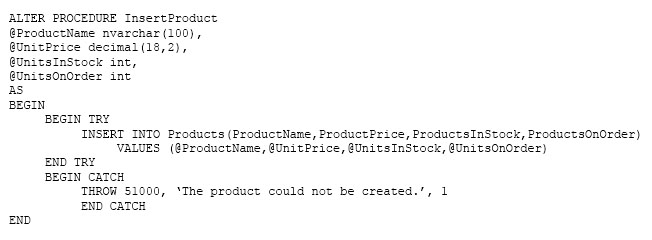

Note: This question is part of a series of questions that present the same scenario. Each question in the series contains a unique solution that might meet the stated goals. Some question sets might have more than one correct solution, while others might not have a correct solution.
After you answer a question in this section. You will NOT be able to return to it. As a result, these questions will not appear in the review screen.
You create a table named Products by running the following Transact-SQL statement:
You have the following stored procedure:
You need to modify the stored procedure to meet the following new requirements:
✑ Insert product records as a single unit of work.
✑ Return error number 51000 when a product fails to insert into the database.
If a product record insert operation fails, the product information must not be permanently written to the database.
Solution: You run the following Transact-SQL statement:
Does the solution meet the goal?
anonimdom
Highly Voted 5 years, 5 months agotcroots19
5 years, 5 months agotz_123
5 years, 1 month agochaoxes
Highly Voted 5 years agoAnirudh_net
Most Recent 3 years, 4 months agoVermonster
4 years, 7 months agolh2607
4 years, 7 months agokyliek7
4 years, 8 months agoAndy7622
4 years, 8 months agoAndy7622
4 years, 8 months agoTheDUdeu
4 years, 10 months agostm22
5 years agoCristianCruz
5 years, 3 months agoBarbedx
5 years, 4 months agoAnsB
5 years, 6 months agoflashed
5 years, 5 months agotcroots19
5 years, 4 months agoMsMartaa
5 years, 6 months agodaniel_yes23
5 years, 2 months agokiri2020
4 years, 10 months ago